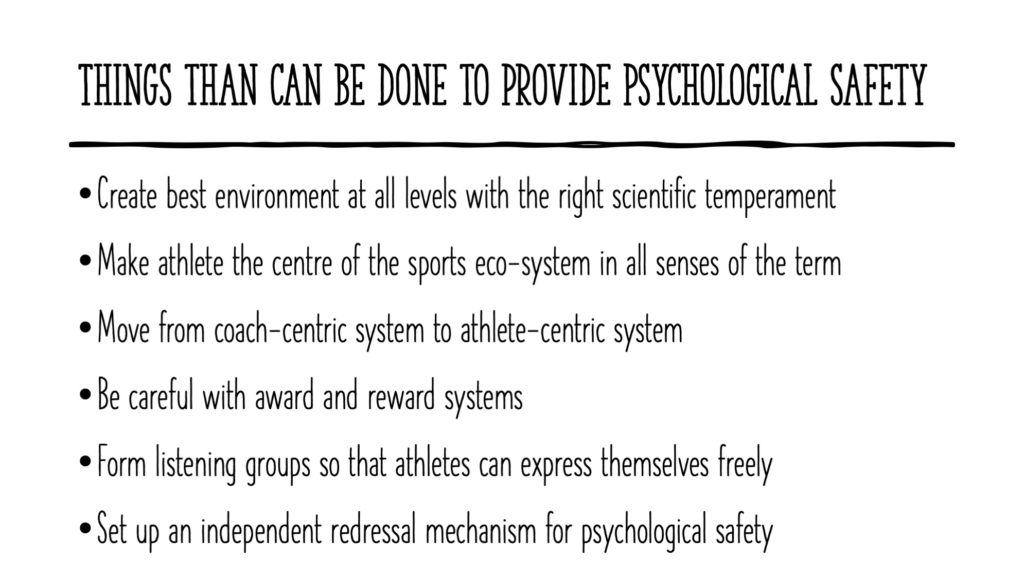Visualise two emotions: Fear as it lurks in a sportsperson’s mind when thinking of a backlash from the system upon speaking up; Hesitation which marks their choice of words if they embark on the task of doing a critical appraisal of coaching staff. And, a third emotion: a devil-may-care approach when throwing caution to the winds and expressing thoughts against selection procedure.
For long, we have seen it rear its ugly head up. Sometime in one sport. At another time, in another discipline. Often in an elite athlete , but more in the lower echelons of Indian sport. Yes, for long, we have known it but have not been able to understand it beyond the instant perspective. Sometimes, we have called it insecurity. At other times, we have branded it fear.
On Saturday, participants of the High Performance Leadership programme by the ELMS Sports Foundation and the Abhinav Bindra Foundation were introduced to the concept of psychological safety. Senior sports psychologist Dr. Sanjana Kiran logged in from Singapore to provoke thinking about the idea that can improve a high-performance athlete’s approach to training and competition.
So, what really is psychological safety? A 1990 study by organisational behaviour specialist William A. Kahn defined psychological safety as feeling able to show and employ one’s self without fear of negative consequences to self-mage, status, or career. In three decades, it is unlikely that there is a more concise and clear definition of the term.
“It’s important to keep human well-being at the heart of high-performance sport. It is a critical aspect,” said Abhinav Bindra, India’s first individual Olympic gold medalist. “Athletes are sensitive human beings. Our focus is sharp and narrow. It is important for sports leaders to be sensitive, be communicating with athletes and make them feel cared for.
“Those in charge of high-performance sport must strike a relationship with athletes which is not just transactional. For, that can limit performance. It could something as simple as picking up the phone and speaking with each athlete at least once in two months. It builds trust. It is hard enough for athletes to build trust in themselves and it’s harder with outsiders,” he said.
Abhinav Bindra called upon leaders of high-performance sport to take that extra step to ensure that there was no discord or disconnect. “Of course, it is also important they maintain a distance which is healthy for the relationship. If we can ensure that human well-being is at the heart of high-performance sport, organisations will only get better,” he said.
Come to think of it, in high-performance sport around the world, psychological safety is typically a function of the coach, but in India, it extends beyond the coach to National Sports Federations and Sports Authority of India, which hosts most National camps. Clearly, much of Indian high-performance sport is now centred around the administrative leadership.
The reported desire of the track and field athletes to leave the National camp in Patiala and Bengaluru and head home is a case in point. Sports Authority of India and the Athletics Federation of India may have strong reasons to retain them in camps, but an approach with mental well-being as its heart may have provoked a slightly different response.
On the contrary, Hockey India’s decision to let the national players return home after the lifting of the lockdown may be a good example of the coaching and administrative staff caring for the mental well-being of the athletes. Hockey India said it was important to give the players a break in the challenging times after having ensure their physical and mental well-being during lockdown.
To its credit, some National Sports Federations have begun to see value in embracing change. For the better. Yet, it is deeply embedded in the minds of athletes and in the system itself.
“I felt psychologically compromised and insecure throughout my career,” Abhinav Bindra said, attributing this state of insecurity to his own self. “I faced a lot of anxiety, struggled with self-belief. As athletes, we are required to take the leap of faith in critical moments. To me, that was challenging.”
He said he found solutions by surrounding himself with extremely positive people who had huge belief in him. “Whenever I felt hopeless, my coaches, my support staff and my family saw hope in me. That brought a great degree of internal security. It was important throughout my journey to have that safety net around me,” he said.
“That came about from the fact that all these people appreciate me not only for my sports career but also love me for the person that I was. The outcome of sports competition did matter to a certain degree, but it was not the only thing on which my relationship with them was built. That is something that is very critical to build this bond, this trust,” Abhinav Bindra said.
The idea of fostering sports culture needs a change if India has to raise the bar at the global level. For instance, coaches need to be able to not only upgrade their knowledge but also be willing to let go of athletes when they are ready for the next level. India must also embrace the concept of psychological safety to ensure more peak performances and, perhaps, more podium finishes.
How can the high-performance sports environment become psychologically safe? There are some simple steps that NSFs and SAI can initiate once they have decided to embrace the concept with utmost sincerity and seriousness. They can invite athletes to open-minded discussions, establish boundaries and promise transparency with the process with a non-judgmental approach.
More importantly, even if the Indian system does not have too many athletes who have had the benefit of scholastic education beyond basic levels, it is crucial for sports leaders to see them as collaborators and not adversaries, to replace blame with curiosity in their communications and to conduct human to human conversations that lets the athletes rid of their fears and insecurities.
Indeed, if sports organisations, across the board, encourage athletes – at all levels – to be the best version of themselves by making them believe that everyone is important with positive reinforcement of a desire to create psychologically safe environments, India can move forward pretty quickly in overhauling its sports culture to being more professional.
And more efficient.




